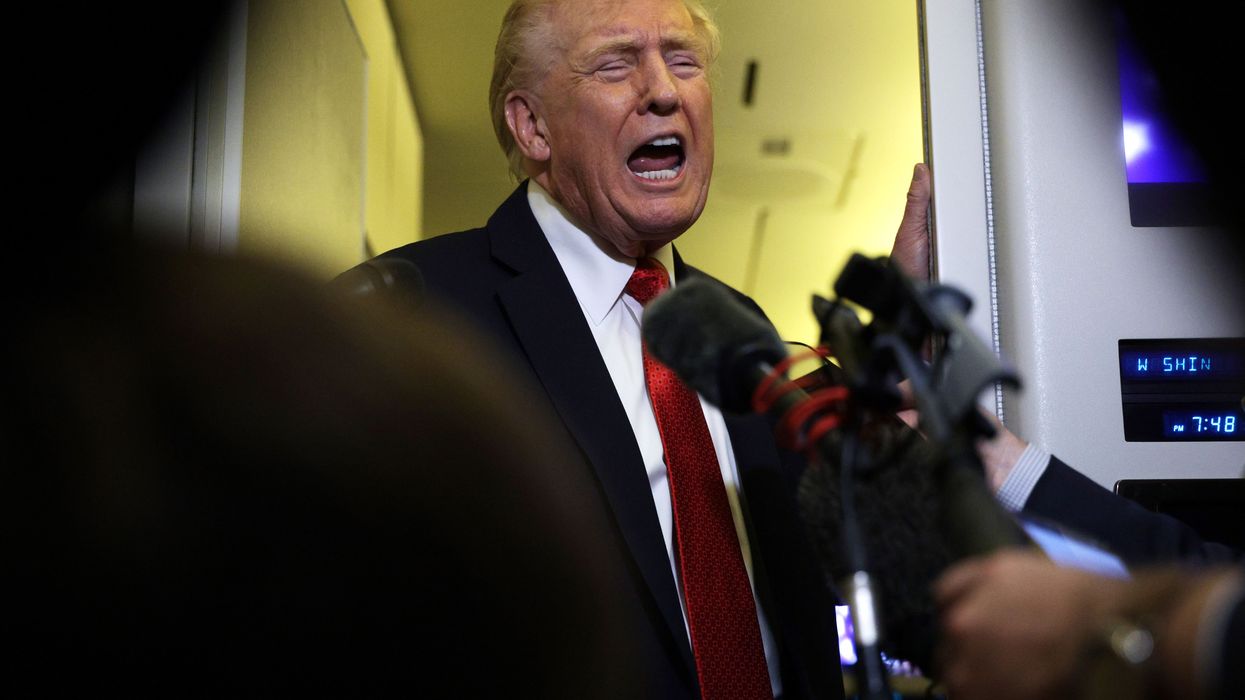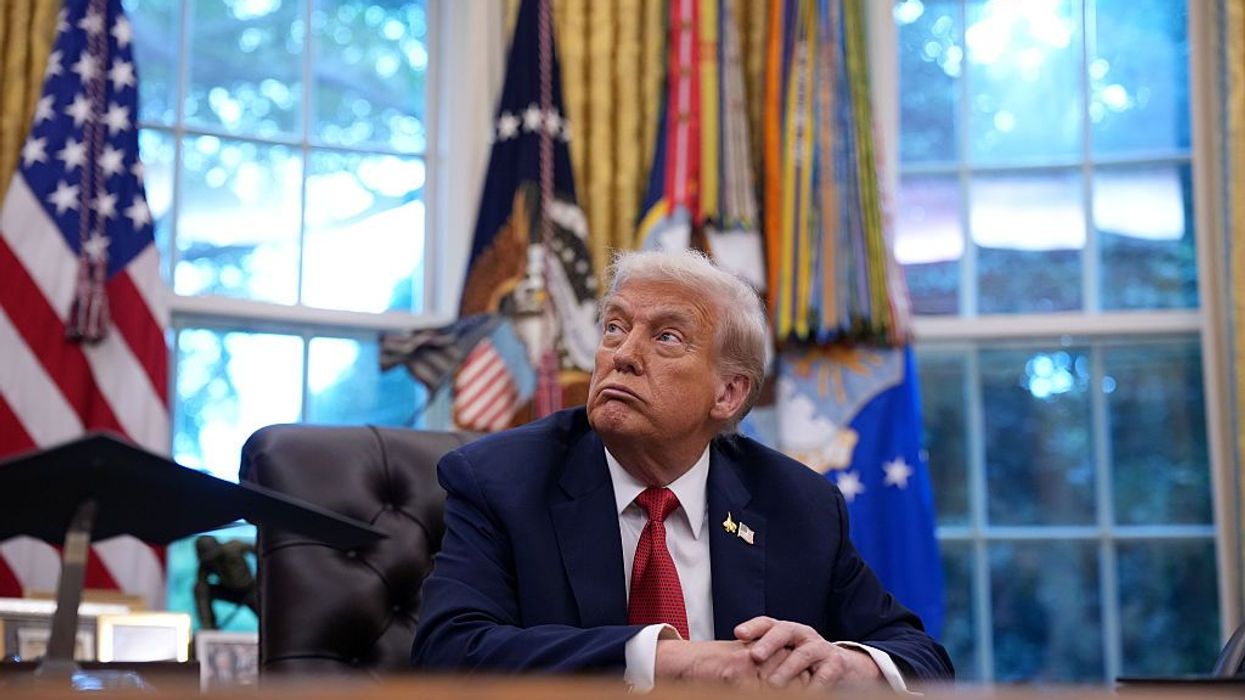On its face, NSPM-7 is chilling to read: If anyone needed proof that “terrorism” and “political violence” are slippery and fraught categories subject to political, ideological, and racial manipulation and bias—well, this is it.
Like the president’s investigation into the Open Society Foundations and his order purporting to designate “Antifa” as a “domestic terrorist organization,” which is not a thing!), NSPM-7 is a deliberate attempt to sow fear and intimidate and silence opposition to the president’s abuses. But true strength in this country comes not from political leaders engaged in fearmongering and political vendettas; it comes from our vibrant civil society, activists, and communities steadfastly pursuing the goals of equality, fairness, and democracy for all. We must not let ourselves be cowed.
The memo is a fever dream of conspiracies, outright falsehoods, and the president’s distorted equation of criticism of his policies by real or perceived political opponents with “criminal and terroristic conspiracies.”
We cannot predict exactly how the memo will be implemented or provide legal advice on the specific questions groups and individuals may have, but here, we lay out what the Memo does not do, what it aims to do, and what it cannot do.
The bottom line in cutting through the noise of reprehensible and irresponsible presidential rhetoric and actions is this: No president can rewrite the Constitution and the safeguards we have under it. These safeguards most emphatically include our First Amendment-protected freedoms of belief, speech, and association; our Fourth Amendment rights against unreasonable searches and seizures; our Fifth Amendment right to due process; and our right to Equal Protection under the laws of this country. Under the 14th Amendment, these due process and equal protection rights apply equally to actions taken by federal and state agencies against tax-exempt nonprofits.
What NSPM-7 Does Not Do
A key thing to know is that the presidential memorandum does not create any new federal powers or crimes.
When the president refers in the memo to “designation” of groups as “domestic terrorism organizations,” that rhetorical label is dangerously stigmatizing and harsh, but it does not in itself have legal force and the president does not cite any authority for it. That is because, unlike for “foreign terrorism,” there is no “domestic terrorism” labelling or designation regime. Congress has passed no law creating any such domestic designation regime, and for very good reason: it would inevitably sweep in First Amendment-protected beliefs, associations, and speech. No matter where civil society groups and activists might fall across the ideological spectrum, from far left to far right, nonpartisan to partisan, religious or not, everyone’s First Amendment rights would be at risk. For that reason, there is also no standalone crime of “domestic terrorism.”
Put another way, any political, legal, or social definition of “terrorism” includes ideological motivation, and there are very serious First Amendment problems with attaching criminal or other sanctions to people or groups based on ideology or belief as opposed to actual, serious criminal conduct—which is already unlawful.
The fact remains: in this country, everyone is entitled to their beliefs and to act on them lawfully without fear of punishment, no matter how extreme or disfavored the government thinks those beliefs are.
What NSPM-7 Aims to Do
The memo is a fever dream of conspiracies, outright falsehoods, and the president’s distorted equation of criticism of his policies by real or perceived political opponents with “criminal and terroristic conspiracies.” It stitches together a few disparate, serious acts of actual or attempted criminal conduct with First Amendment-protected beliefs and protests against the president and his policies, and wrongly conflates them as “political violence.” It ignores what any responsible understanding of actual political violence would make clear: political violence does not fit into neat ideological buckets and while increasing in frequency, it remains rare. After all, the January 6, 2021 attack on the Capitol by the president’s supporters is a paradigmatic example of actual political violence, but NSPM-7 pointedly fails even to mention it.
Perhaps the most chilling rhetorical move the president makes is to use vague, broad labels that, even if true—and there’s good reason to question the truth of virtually all of the memo’s assertions—encompass First Amendment-protected beliefs unconnected to any actual criminal conduct. These labels include: “Anti-Americanism, anti-capitalism, and anti-Christianity,” “support for the overthrow of” the federal government, “extremism on migration, race, and gender,” and opposition to “traditional American views on family, religion, and morality.” The president even bizarrely imagines that “support for law enforcement and border control” are “foundational American principles” that his political opponents paint as “fascist” to encourage violence. No wonder many in civil society see NSPM-7’s rhetoric as a threat to human rights, civil liberties, and democracy-building work.
Through the memo, the president instructs federal departments and law enforcement agencies to use authorities they already have and focus them on investigations of civil society groups — including nonprofits, activists, and donors—to “disrupt” and “prevent” the president’s fever-dream version of “terrorism” and “political violence.”
NSPM-7 Uses Already Vague, Overbroad, and Abused Federal “Domestic Terrorism” Powers
To understand the fundamentals of these existing authorities—and how they are abused— it helps to know what is already on the books. When Congress passed the USA Patriot Act in 2001, it defined domestic terrorism as acts that are dangerous to human life and already criminal, which are intended to intimidate or coerce a civilian population or influence government policy or conduct. Again, this definition is not itself a “domestic terrorism” crime; federal agencies use it for investigative purposes.
As the ACLU and other rights groups have consistently criticized in the decades since 2001, federal agencies have used the Patriot Act “domestic terrorism” definition to claim expansive authorities to investigate and surveil people and groups with little or no factual, evidentiary basis, including those engaged in First Amendment-protected protest and other activities. Indeed, the Justice and Homeland Security Departments have for decades created categories of investigative priorities ostensibly focused on “violent extremists” with a variety of what the agencies describe as “ideological agendas”—ranging from “racially and ethnically motivated” to “anti-government/anti-authority” to “potential bias related to religion, gender, or sexual orientation,” and more.
In other words, abusive use of “domestic terrorism” investigative authority is not a new problem, but it is a serious one.
One important, concrete thing we can do for ourselves and our communities is, therefore, to educate people about the variety of scenarios in which they may encounter federal agencies and their rights in those scenarios—particularly if questioned by law enforcement agencies and when exercising the rights to free speech and protest. And if, in fact, an individual or group is actually investigated, invoke the right to a lawyer.
NSPM-7 Instructs Joint Terrorism Task Forces to Conduct Investigations
The memo instructs Joint Terrorism Task Forces (JTTFs) to conduct investigations. Here, it helps to know what JTTFs are, the rights concerns they’ve long raised, and measures to help mitigate some of these issues.
JTTFs are FBI-operated task forces that are intended to work with state and local law enforcement agencies to conduct counterterrorism investigations. There are about 200 JTTFs throughout the country, including at least one in each of the FBI’s 56 field offices. They operate with little transparency or meaningful oversight and we have long raised serious red flags about their privacy, civil rights, and civil liberties violations.
JTTFs in major cities have monitored Black Lives Matter activists, targeted Muslims, journalists, and environmentalists for investigation, including with intimidating visits to their homes or workplaces and, in May 2020, then-Attorney General William Barr announced that JTTFs would be used in response to racial justice protests. It’s perhaps no surprise that President Trump would again use JTTFs to target real or perceived critics for surveillance and investigation.
The memo tells JTTFs to investigate “potential federal crimes relating to” “recruiting or radicalizing” people for what it describes as “political violence, terrorism, or conspiracy against rights” as well as investigations of funders and their leadership. It widens an already open door to politicized rights-violating enforcement. It also assigns to JTTFs investigation of violations of the Foreign Agent Registration Act (FARA), a law requiring individuals or groups who are defined broadly as acting as “agents” of foreign governments or political entities to register with the government and disclose extensive information about their associations and activities. Government enforcement of FARA, too, has raised constitutional issues virtually since it was passed. FARA’s terms are so broad and vague that they raise concern it could be read to apply to nonprofits, journalists, and others with some “agency” connection to foreign groups or entities. Its registration and disclosure requirements could chill a wide range of speech on issues of public concern. As with the memo’s approach writ large, the government could selectively target speakers for their viewpoints in violation of the First Amendment. Again, it’s important to know your rights if approached, questioned, or investigated by federal law enforcement agents—whether they are part of a JTTF or not.
NSPM-7 Tasks Other Federal Departments and Agencies with Problematic Investigations
NSPM-7 also tasks other departments and agencies with investigations and actions that are already within their purview, and that could raise significant constitutional concerns depending on their implementation. We’ll be watching, for example, to see if NSPM-7’s instruction to the Justice Department to issue guidance on investigation of “politically-motivated” acts and “identification of any behaviors, fact patterns, recurrent motivations, or other indicia common to organizations and entities that coordinate these acts” results in investigations and retaliation for groups and people engaging in First Amendment-protected activities.
The memo also instructs the Treasury Department and IRS to pursue investigations using their existing authorities. It’s worth emphasizing that in a tax code provision aptly titled “Prohibition on Executive Branch Influence over Taxpayer Audits and Investigations,” Congress made it a felony for top officials, including the president, to use the IRS for politically-motivated retaliatory investigation and actions. In any event, anticipating the harm to nonprofits and tax-exempt groups from unwarranted investigations, civil society groups have already issued guidance on compliance and preparation.
How State and Local Governments Can Help Protect Residents from Federal Abuses
States and local governments can also act to protect their residents and the nonprofit and tax-exempt groups in their states: They can end or limit their participation in JTTFs and other similar joint federal, state, and local law enforcement investigative and surveillance partnerships. They can prohibit or limit data-sharing with federal agencies through these partnerships. At a minimum, states and local governments must make agreements governing these partnerships with federal agencies public.
Indeed, police forces in some of the nation’s largest cities, including Atlanta, San Francisco, Oakland, and Portland, have chosen to leave or limit cooperation with JTTFs because of disputes with federal officials over transparency and accountability for abuses. That’s in part because these task forces are structured to deputize state and local law enforcement officers so they act with the authority and immunities of federal agents—sometimes anywhere in the country. Because state and local laws may provide stronger protections for residents’ privacy, civil rights, and civil liberties than federal law, JTTFs can effectively function to shield state and local officers from accountability for violations of their own states’ laws.
In short, by withdrawing from or limiting participation in JTTFs and other federal-state task forces, state and local governments can both protect residents and ensure their own oversight over their law enforcement agencies.
Why NSPM-7 Cannot Rewrite Our Constitutional Rights
The president cannot rewrite the Constitution by memo or otherwise. No matter what the president says or tries to do through NSPM-7, the First Amendment constrains what federal agencies can do when it comes to punishing groups and people for exercising their rights to free speech, peaceful protest, and supporting causes by making donations. It also safeguards against viewpoint-based government discrimination, coercion, and retaliation.
If any U.S. group or person is investigated or prosecuted, the Constitution guarantees the right to due process—requiring notice and a meaningful opportunity to challenge wrongful government conduct. And if, for example, a particular group or organization is targeted based on protected characteristics—race, national origin, religion, sex, age, disability, sexual orientation, gender identity—the right to equal protection under the laws and other rights would apply. Under the 14th Amendment, these due process and equal protection rights also apply to federal and state agencies’ actions against tax-exempt nonprofits.
In short, no president—of any party—should have the power to punish nonprofit organizations and activists simply because he disagrees with them. Sadly, however, the government using intimidation tactics against those standing up for human rights and civil liberties is not new in this country’s history. Extreme as the memo is, it echoes past and ongoing abuses of executive power.
For example, the president’s strategy “to investigate and disrupt networks, entities, and organizations” harkens straight back to the Civil Rights Era, when J. Edgar Hoover’s FBI launched a top-secret program “to expose, disrupt, misdirect, discredit, or otherwise neutralize” Black leaders, civil rights groups, and protest, particularly when it was Black and student-led. That Counter Intelligence Program (COINTELPRO), grew to encompass also-discriminatory and unwarranted investigations of labor unions, and Native American, Latino, and other rights and social justice groups. Eventually, the massively rights-violating law enforcement abuses of the Civil Rights Era resulted in a landmark congressional investigation, called the Church Committee, and an overhaul of national security and intelligence agencies and their authorities that was intended to protect civil liberties and rights.
But in the post-9/11 era, presidents, agencies themselves, and Congress undid many of those post-Civil Rights Era national security and intelligence-agency reforms. And in many ways, the story of the last 20 years is a story of how Black, brown, and Muslim communities and groups bore the brunt of the resulting executive branch abuses. These abuses spread—as government abuses do—to AAPI communities, racial and social justice activists, environmental and animal rights movements, pro-Palestinian groups and activists, and so many others with beliefs the government has deemed unpopular or controversial.
Ultimately, we need another generational overhaul of federal agencies’ law enforcement and intelligence authority, which can only come from Congress, and pressure from all of us to achieve it. Until then, we can arm ourselves with knowledge and a recognition that chilling as NSPM-7 is, and painful and difficult though its implementation may well prove to be, it contains nothing that we have not seen before. Civil society groups and activists have worked hard to survive other similar moments in our history. We must do so again, in solidarity with nonprofit groups and leaders who are or will be unjustly and illegally targeted by the Trump administration. No president can take that away from us.


